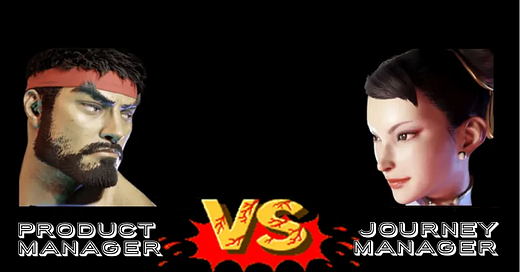Product Managers Vs Journey Managers
A deep dive into how these roles work together in Customer Journey Management
I recently attended an excellent webinar Journey-led Vs Product-led with John Cutler & Jochem van der Veer. This was a rollercoaster across a range of topics (as John Cutler often tends to provide).
One question posed to John was ‘Should we use Journey Managers or Product Managers?’ to which he relied he didn’t like labels.
This set me thinking on the role of Journey Managers and Product Managers in a Customer Journey Management setup. I am especially interested in aligning Customer Journey Management to modern Product Management frameworks like Marty Cagan’s Product Model, Teresa Torres’s Continuous Discovery, and Team Topologies my Matthew Skelton and Manual Pais.
Here are some thoughts.
Why do we need a Journey Manager?
Customer Journey Management reimagines the customer journey.
In traditional design thinking, this was an artefact of the process, like a printed document, a pdf or a wall covered in sticky notes.
The research is conducted, the information is synthesised and a customer journey map is created, once, on a wall or a digital whiteboard.
At the end of the design thinking process, all of this information is either put in a slide deck, left on a wall or put in a drawer somewhere.
Customers Journeys as a collaboration framework
Customer Journey Management reimagines customer journeys as a collaboration framework, that we use continuously to store customer experience data.
And we organise people, processes and technology around this.
Customer Journeys become the central source of truth that innovation is organised around.
For a business embarking on a Journey'-led approach there are a few new roles, alongside existing digital roles, that are required to successfully manage journeys as the central hub for innovation collaboration.
What is a Journey Manager?
Drawing from Marty Cagan’s Product Model, we can define the role of a Journey Manager in Customer Journey Management is to be responsible and accountable for addressing value and viability risk across a customer journey.
Activities include:
Define Journey Success: Setting journey goals and metrics and aligning these to business goals
Outwards facing Stakeholder management: Journey Managers are outwards facing and align leadership and other business stakeholders beyond the customer journeys to the goals and needs of teams working on the journey.
Aligning journey outcomes to product team outcomes: Working with product and delivery managers to align product goals to journey goals and ensure delivery teams are focussed on value for the customer journey.
Communicating the customer journey: including the business value this creates and the positive impact of innovation to the wider business.
This aligns to the Marty Cagan view on the role of product managers in his product model, but they operate at the level of the customer journey.
Will journey managers replace product managers?
In short, no. The product manager role is here to stay for a variety of reasons:
Digital products are usually complex and need a person or several people to manage value and viability at the product level. A customer journey can be supported by many products, which would be too much for one person to manage.
Product Management is well established in businesses across the world. It would be enormously difficult, and counter productive, for businesses to re-engineer this well understood role into something else. There is too much investment to reinvent the wheel.
The product model is growing. Countless product thought leaders advocate for this approach. Marty Cagan has, in the last few weeks, released his new book to redefine how businesses transform to the product model. If anything, product management will continue to expand as a discipline.
Where do journey managers and product managers overlap?
The product manager role is very broad, and there are in fact several product manager archetypes which perform quite different functions for an organisation. Here is a great breakdown from Adam Fishman:
Article: https://lnkd.in/dBx7_hU3
LinkedIn - March 2024
Some of these roles are much more suited to become Journey Managers than others.
The Archetypes that are suited to become Journey Managers
Looking at the archetypes above, there are two that stand out as ideal candidates to change roles to a Journey Manager when applying Customer Journey Management:
UX-Inclined
The work of UX-Inclined product managers is massively simplified through Customer Journey Management.
All of the skills and behaviours are applied inn a Journey Manager role. And all the information required to succeed is stored in a well organised Journey Framework.
Basically, for UX-Inclined Product Managers, Customer Journey Management is like a super power that supports every aspect of your work.
Growth
Growth product management is, in my opinion, really just a subset of CX work.
The customer experience focus is limited solely to growth . (A business always has growth metrics, and often also has other customer experience metrics alongside to speak to the wider business mission, so a growth focus is a subset of the full customer experience.)
The customer journey optimisation is limited to sales, marketing, product and customer success. This is a large part of a successful business, but is a subset of the entire business that supports the customer experience.
Growth product managers can benefit a lot from Customer Journey Management, similar to UX-Inclined product managers, as all the information on the customer journey to value is stored centrally in a journey framework. Growth product managers are good candidates for Journey Managers.
The Archetypes that may be suited to become Journey Managers
There are two more product manager archetypes that are less directly suited to become Journey Managers. but might benefit from this in some companies.
Optimizer
An optimizer product manager can benefit a lot from customer journey management because it provides rich customer insight across the journey that helps to identify opportunities to optimise. This is especially true for opportunities that occur across journeys and across teams, which can be difficult to pick up when focussed on a single product.
In reality, there will be a lot of optimisation required at the product level, so this is a less strong candidate to translate to a Journey Manager.
General manager
An general manager could also make sense as a Journey Manager, if they are UX-inclined, growth focussed and an optimizer.
The ideal Customer Journey Manager would in fact combine the skills of these three archetypes.
Advocating for Customer Journey Management as a Product Management tool
Currently the CX and service design communities are excited about the potential of Customer Journey Management. There is a lot less buzz in the product community.
But product managers stand to gain a lot from Customer Journey Management because it supports:
A relentless focus on the customer (Product managers love this!)
A centralised source of CX data to support effective story telling (Critical to the PM role)
A map of where products interlink with upstream and downstream processes (Such a time saver)
(And there are several more reasons.)
This is especially true for Product Manager archetypes that can translate to Customer Journey Managers.
If you are a UX-Inclined, Growth focussed or Optimizing Product Manager, Customer Journey Management is a trend worth following as this approach has benefits that directly support your role and can positively impact your future career.
Are you a product managers working with Customer Journey management?
Are you a product manager that sees great potential in Customer Journey Management? Are you figuring out how to embed product approaches, roles and responsibilities around Customer Journeys.
If so, please do connect on LinkedIn and start a conversation. I would love to hear how this is working in your context and share experiences around this.













